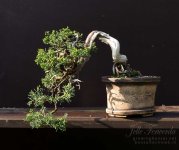zizz
Seedling
Hello! I'm pretty new to bonsai and after my JBP died, I did more research on proper care, and went grabbed some more, including this chinese juniper, along with chinese elm and larch.
Today I decided to give it a good clean up as it's pretty overgrown (first image), it's my first time to actually practice big pruning like this, other than a bit of a clip on the elm.
Here are my questions:
1. Am I cutting off too much foliage? I know many people say do not cut off more than 50% of the overall mass, so I'm a bit concerned.
2. Is it the right move to leave the remaining foliages long like this? I'm a bit scared to cut it back further, and maybe leave it that way will thicken the branches a bit overtime?
3. How to move forward in terms of styling, initially I was thinking going towards cascade or semi cascade, but after pruning, I'm not really sure anymore. I do have aluminum wires in different thicknesses, but I'm trying to get an idea first before wiring it up.
Please share your thoughts, thanks for reading.
Today I decided to give it a good clean up as it's pretty overgrown (first image), it's my first time to actually practice big pruning like this, other than a bit of a clip on the elm.
Here are my questions:
1. Am I cutting off too much foliage? I know many people say do not cut off more than 50% of the overall mass, so I'm a bit concerned.
2. Is it the right move to leave the remaining foliages long like this? I'm a bit scared to cut it back further, and maybe leave it that way will thicken the branches a bit overtime?
3. How to move forward in terms of styling, initially I was thinking going towards cascade or semi cascade, but after pruning, I'm not really sure anymore. I do have aluminum wires in different thicknesses, but I'm trying to get an idea first before wiring it up.
Please share your thoughts, thanks for reading.












